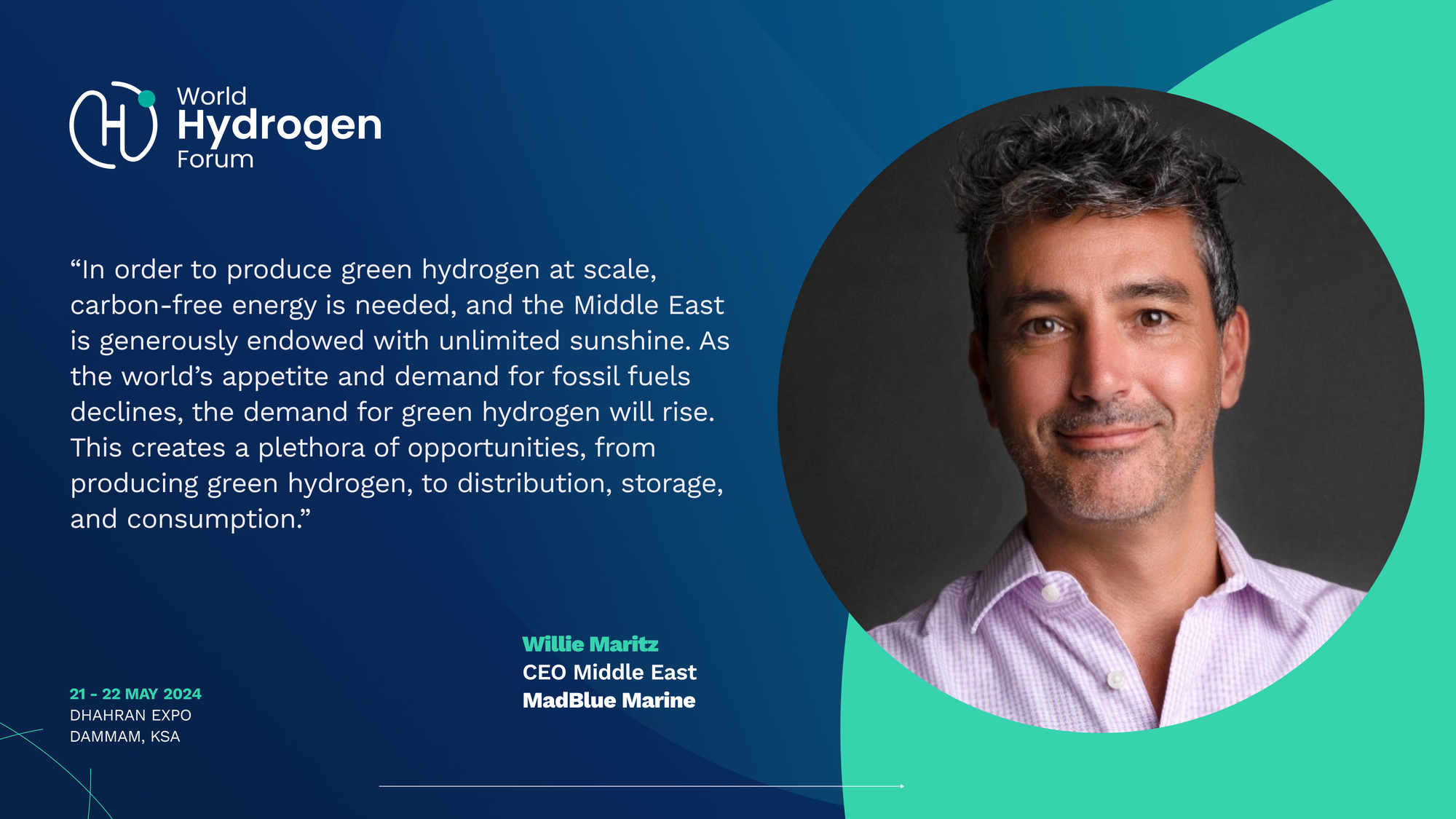We're thrilled to announce a captivating Q&A session with Willie Maritz, CEO of MadBlue Marine (Middle East). A seasoned entrepreneur passionate about sustainability, Willie leads the charge in revolutionising the marine industry with hydrogen-powered vessels. Join us as he discusses innovative strategies for decarbonising marine transport, the potential of on-vessel green hydrogen production, and the Middle East's unique role in this sustainable energy future. This Q&A session offers valuable insights for investors, innovators, and anyone concerned about the environmental impact of marine transportation.
#WHF: How does hydrogen fuel contribute as a solution to decarbonize marine transport, specifically in facilitating the transition to net-zero emissions, particularly within urban marine environments?
#Willie Maritz: Urban marine transport is notoriously bad for the environment. Not only do these boats cause significant oil and fuel spills, they also emit more carbon pollution per passenger mile than other forms of transport. One only needs to go for a stroll in the average leisure marina to be moved by the smell of diesel fumes and the unsightly layer of oil on the water.
The first tier solution to this problem is electric boats. Unfortunately, in most cases electric boats only move the carbon footprint from the marina to the source of electricity production. Also the environmental impact of sourcing minerals for battery production is quite significant and often under accounted for.
In comes hydrogen as a second tier solution. Hydrogen can be produced sustainably in marinas, making use of solar energy and water. Hydrogen boats do make use of batteries, but only limited capacity to manage the variable power delivery between the hydrogen fuel cell and the electric engine. The hydrogen system on board has no carbon emissions. The only by-product from the hydrogen-to-electricity process is water.
Hydrogen can also deliver a longer journey range than electricity, which in turn facilitates higher energy efficiencies and higher operational efficiencies.
#WHF: I'm curious about the innovative implementation of 'on-vessel green hydrogen production”. Can you elaborate on how this technology operates and illustrate its potential to revolutionise sustainability in marine transportation?
#Willie Maritz: In simple terms, solar or wind energy on a boat is used to produce zero carbon electricity. This electricity is directed to an electrolyzer, where water (H2O) is split into its constituent elements, hydrogen (H2) and oxygen (O2). The hydrogen is collected and stored in a compressed cylinder on the boat. When needed, the hydrogen is pushed through a fuel cell, which applies an electrochemical process to produce electricity. The only emission from this process is water.
On the boat, this electricity can be used for powering on-board electric devices like lights, heat pumps, and navigation equipment. If there is enough hydrogen and electricity available, it can also be used to power an electric engine for propulsion.
The “enough hydrogen” is the biggest barrier to overcome to make boats completely energy independent. In order to produce enough hydrogen, engineers are trying to capture as much solar, wind and hydro-power as possible on the boat. Most boats do not have enough space to host enough energy production devices like wind turbines and solar panels. This limitation might be overcome fairly soon as solar panel efficiencies are rapidly improving.
#WHF: What specific opportunities are available for companies interested in investing or establishing a presence in the Middle East within the realm of green hydrogen production? How can the region leverage its expertise to attract and facilitate global investment in this technology?
#Willie Maritz: Green hydrogen is seen by most energy specialists as a key component in creating a carbon-neutral energy future. Hydrogen already plays a major role as an energy storage solution that is more environmentally friendly than batteries. The use cases for hydrogen range from large scale steel production, large scale grid load balancing, heavy transport, to a variety of passenger mobility solutions.
In order to produce green hydrogen at scale, carbon-free energy is needed, and the Middle East is generously endowed with unlimited sunshine. As the world’s appetite and demand for fossil fuels declines, the demand for green hydrogen will rise. This creates a plethora of opportunities, from producing green hydrogen, to distribution, storage, and consumption.
The Middle East has for many generations played a role as an energy supplier to the world. By investing in green hydrogen infrastructure, Middle Eastern governments and companies can continue to capitalize on their energy supply expertise, strategic relationships and global reputation.
#WHF: In what ways do global events such as the World Hydrogen Forum contribute to the advancement of green hydrogen technology by fostering collaboration, innovation, and investment, from your perspective?
#Willie Maritz: Hydrogen and green hydrogen is not a new kid on the block. It has been around for a long time, but its large-scale adoption has been hampered by high costs and low efficiencies in energy transition. We need to overcome these challenges, in the interest of a sustainable future for our planet. The key to overcoming these challenges is collaboration across the ecosystem.
Conferences like the World Hydrogen Forum have a critical role to play to bring stakeholders together for exactly this purpose. Scientists should have an opportunity to learn from each other. Governments should have the opportunity to assess the landscape for their energy strategies. Enterprises should be exposed to the exciting possibilities for reducing their carbon footprint. Entrepreneurs should get inspiration for creating solutions.
When all these stakeholders collaborate, a balanced supply/demand economic system is created that reduces risk and incentivises innovation and investment.

